[English] 日本語
 Yorodumi
Yorodumi- PDB-3bt2: Structure of urokinase receptor, urokinase and vitronectin complex -
+ Open data
Open data
- Basic information
Basic information
| Entry | Database: PDB / ID: 3bt2 | |||||||||
|---|---|---|---|---|---|---|---|---|---|---|
| Title | Structure of urokinase receptor, urokinase and vitronectin complex | |||||||||
 Components Components |
| |||||||||
 Keywords Keywords |  IMMUNE SYSTEM / IMMUNE SYSTEM /  protein-protein interaction / protein-protein interaction /  Glycoprotein / Glycoprotein /  GPI-anchor / GPI-anchor /  Lipoprotein / Lipoprotein /  Membrane / Receptor / Membrane / Receptor /  Secreted / Secreted /  Blood coagulation / Blood coagulation /  EGF-like domain / EGF-like domain /  Fibrinolysis / Fibrinolysis /  Hydrolase / Hydrolase /  Kringle / Kringle /  Phosphoprotein / Plasminogen activation / Phosphoprotein / Plasminogen activation /  Protease / Protease /  Serine protease / Serine protease /  Zymogen / Zymogen /  Cell adhesion / Heparin-binding / Cell adhesion / Heparin-binding /  Sulfation / Sulfation /  Immunoglobulin domain Immunoglobulin domain | |||||||||
| Function / homology |  Function and homology information Function and homology information urokinase plasminogen activator receptor activity / Attachment of GPI anchor to uPAR / rough endoplasmic reticulum lumen / smooth muscle cell-matrix adhesion / urokinase plasminogen activator receptor activity / Attachment of GPI anchor to uPAR / rough endoplasmic reticulum lumen / smooth muscle cell-matrix adhesion /  peptidase inhibitor complex / positive regulation of homotypic cell-cell adhesion / negative regulation of cysteine-type endopeptidase activity involved in apoptotic signaling pathway / alphav-beta3 integrin-vitronectin complex / peptidase inhibitor complex / positive regulation of homotypic cell-cell adhesion / negative regulation of cysteine-type endopeptidase activity involved in apoptotic signaling pathway / alphav-beta3 integrin-vitronectin complex /  u-plasminogen activator / regulation of smooth muscle cell-matrix adhesion ... u-plasminogen activator / regulation of smooth muscle cell-matrix adhesion ... urokinase plasminogen activator receptor activity / Attachment of GPI anchor to uPAR / rough endoplasmic reticulum lumen / smooth muscle cell-matrix adhesion / urokinase plasminogen activator receptor activity / Attachment of GPI anchor to uPAR / rough endoplasmic reticulum lumen / smooth muscle cell-matrix adhesion /  peptidase inhibitor complex / positive regulation of homotypic cell-cell adhesion / negative regulation of cysteine-type endopeptidase activity involved in apoptotic signaling pathway / alphav-beta3 integrin-vitronectin complex / peptidase inhibitor complex / positive regulation of homotypic cell-cell adhesion / negative regulation of cysteine-type endopeptidase activity involved in apoptotic signaling pathway / alphav-beta3 integrin-vitronectin complex /  u-plasminogen activator / regulation of smooth muscle cell-matrix adhesion / scavenger receptor activity / urokinase plasminogen activator signaling pathway / regulation of plasminogen activation / u-plasminogen activator / regulation of smooth muscle cell-matrix adhesion / scavenger receptor activity / urokinase plasminogen activator signaling pathway / regulation of plasminogen activation /  regulation of fibrinolysis / negative regulation of endopeptidase activity / regulation of fibrinolysis / negative regulation of endopeptidase activity /  regulation of wound healing / protein complex involved in cell-matrix adhesion / regulation of wound healing / protein complex involved in cell-matrix adhesion /  regulation of proteolysis / negative regulation of plasminogen activation / negative regulation of blood coagulation / regulation of smooth muscle cell migration / regulation of proteolysis / negative regulation of plasminogen activation / negative regulation of blood coagulation / regulation of smooth muscle cell migration /  regulation of signaling receptor activity / regulation of signaling receptor activity /  extracellular matrix binding / positive regulation of vascular endothelial growth factor receptor signaling pathway / serine-type endopeptidase complex / Dissolution of Fibrin Clot / positive regulation of cell-substrate adhesion / Molecules associated with elastic fibres / cell adhesion mediated by integrin / smooth muscle cell migration / extracellular matrix structural constituent / positive regulation of epidermal growth factor receptor signaling pathway / Syndecan interactions / extracellular matrix binding / positive regulation of vascular endothelial growth factor receptor signaling pathway / serine-type endopeptidase complex / Dissolution of Fibrin Clot / positive regulation of cell-substrate adhesion / Molecules associated with elastic fibres / cell adhesion mediated by integrin / smooth muscle cell migration / extracellular matrix structural constituent / positive regulation of epidermal growth factor receptor signaling pathway / Syndecan interactions /  polysaccharide binding / polysaccharide binding /  extrinsic component of membrane / positive regulation of wound healing / plasminogen activation / positive regulation of smooth muscle cell migration / oligodendrocyte differentiation / endodermal cell differentiation / tertiary granule membrane / regulation of cell adhesion mediated by integrin / positive regulation of release of cytochrome c from mitochondria / protein polymerization / extrinsic component of membrane / positive regulation of wound healing / plasminogen activation / positive regulation of smooth muscle cell migration / oligodendrocyte differentiation / endodermal cell differentiation / tertiary granule membrane / regulation of cell adhesion mediated by integrin / positive regulation of release of cytochrome c from mitochondria / protein polymerization /  basement membrane / ECM proteoglycans / positive regulation of DNA binding / Integrin cell surface interactions / negative regulation of fibrinolysis / negative regulation of intrinsic apoptotic signaling pathway / specific granule membrane / basement membrane / ECM proteoglycans / positive regulation of DNA binding / Integrin cell surface interactions / negative regulation of fibrinolysis / negative regulation of intrinsic apoptotic signaling pathway / specific granule membrane /  regulation of cell adhesion / regulation of cell adhesion /  serine protease inhibitor complex / serine protease inhibitor complex /  fibrinolysis / fibrinolysis /  collagen binding / extracellular matrix organization / cell-matrix adhesion / cell projection / collagen binding / extracellular matrix organization / cell-matrix adhesion / cell projection /  liver regeneration / liver regeneration /  Regulation of Complement cascade / Golgi lumen / positive regulation of receptor-mediated endocytosis / Regulation of Complement cascade / Golgi lumen / positive regulation of receptor-mediated endocytosis /  chemotaxis / chemotaxis /  cell migration / positive regulation of peptidyl-tyrosine phosphorylation / cell migration / positive regulation of peptidyl-tyrosine phosphorylation /  blood coagulation / blood coagulation /  integrin binding / integrin binding /  signaling receptor activity / signaling receptor activity /  heparin binding / regulation of cell population proliferation / positive regulation of protein binding / collagen-containing extracellular matrix / blood microparticle / response to hypoxia / heparin binding / regulation of cell population proliferation / positive regulation of protein binding / collagen-containing extracellular matrix / blood microparticle / response to hypoxia /  cell adhesion / positive regulation of cell migration / cell adhesion / positive regulation of cell migration /  immune response / positive regulation of protein phosphorylation / protein domain specific binding / external side of plasma membrane / immune response / positive regulation of protein phosphorylation / protein domain specific binding / external side of plasma membrane /  endoplasmic reticulum lumen / endoplasmic reticulum lumen /  signaling receptor binding / serine-type endopeptidase activity / signaling receptor binding / serine-type endopeptidase activity /  focal adhesion / intracellular membrane-bounded organelle / Neutrophil degranulation / endoplasmic reticulum membrane / negative regulation of apoptotic process / focal adhesion / intracellular membrane-bounded organelle / Neutrophil degranulation / endoplasmic reticulum membrane / negative regulation of apoptotic process /  enzyme binding / enzyme binding /  cell surface / cell surface /  endoplasmic reticulum / endoplasmic reticulum /  signal transduction / signal transduction /  proteolysis / proteolysis /  extracellular space / extracellular exosome / extracellular region / extracellular space / extracellular exosome / extracellular region /  membrane / identical protein binding / membrane / identical protein binding /  plasma membrane plasma membraneSimilarity search - Function | |||||||||
| Biological species |   Homo sapiens (human) Homo sapiens (human)  Mus musculus (house mouse) Mus musculus (house mouse) | |||||||||
| Method |  X-RAY DIFFRACTION / X-RAY DIFFRACTION /  SYNCHROTRON / SYNCHROTRON /  MOLECULAR REPLACEMENT / Resolution: 2.5 Å MOLECULAR REPLACEMENT / Resolution: 2.5 Å | |||||||||
 Authors Authors | Huang, M. | |||||||||
 Citation Citation |  Journal: Nat.Struct.Mol.Biol. / Year: 2008 Journal: Nat.Struct.Mol.Biol. / Year: 2008Title: Crystal structures of two human vitronectin, urokinase and urokinase receptor complexes Authors: Huai, Q. / Zhou, A. / Lin, L. / Mazar, A.P. / Parry, G.C. / Callahan, J. / Shaw, D.E. / Furie, B. / Furie, B.C. / Huang, M. | |||||||||
| History |
|
- Structure visualization
Structure visualization
| Structure viewer | Molecule:  Molmil Molmil Jmol/JSmol Jmol/JSmol |
|---|
- Downloads & links
Downloads & links
- Download
Download
| PDBx/mmCIF format |  3bt2.cif.gz 3bt2.cif.gz | 181.8 KB | Display |  PDBx/mmCIF format PDBx/mmCIF format |
|---|---|---|---|---|
| PDB format |  pdb3bt2.ent.gz pdb3bt2.ent.gz | 141.5 KB | Display |  PDB format PDB format |
| PDBx/mmJSON format |  3bt2.json.gz 3bt2.json.gz | Tree view |  PDBx/mmJSON format PDBx/mmJSON format | |
| Others |  Other downloads Other downloads |
-Validation report
| Arichive directory |  https://data.pdbj.org/pub/pdb/validation_reports/bt/3bt2 https://data.pdbj.org/pub/pdb/validation_reports/bt/3bt2 ftp://data.pdbj.org/pub/pdb/validation_reports/bt/3bt2 ftp://data.pdbj.org/pub/pdb/validation_reports/bt/3bt2 | HTTPS FTP |
|---|
-Related structure data
| Related structure data |  3bt1C 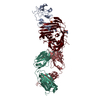 2fd6S S: Starting model for refinement C: citing same article ( |
|---|---|
| Similar structure data |
- Links
Links
- Assembly
Assembly
| Deposited unit | 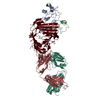
| ||||||||
|---|---|---|---|---|---|---|---|---|---|
| 1 |
| ||||||||
| 2 | 
| ||||||||
| 3 | 
| ||||||||
| Unit cell |
|
- Components
Components
-Protein , 2 types, 2 molecules AU
| #1: Protein |  Urokinase / uPA / U-plasminogen activator Urokinase / uPA / U-plasminogen activatorMass: 15359.318 Da / Num. of mol.: 1 Fragment: urokinase amino terminal fragment, Urokinase-type plasminogen activator long chain A, UNP residues 21-153 Source method: isolated from a genetically manipulated source Source: (gene. exp.)   Homo sapiens (human) / Gene: PLAU / Plasmid: pMT/Bip / Species (production host): Escherichia coli / Production host: Homo sapiens (human) / Gene: PLAU / Plasmid: pMT/Bip / Species (production host): Escherichia coli / Production host:   Escherichia coli BL21 (bacteria) / Strain (production host): BL21 / References: UniProt: P00749 Escherichia coli BL21 (bacteria) / Strain (production host): BL21 / References: UniProt: P00749 |
|---|---|
| #5: Protein |  Urokinase receptor / uPAR / U-PAR / Monocyte activation antigen Mo3 / CD87 antigen Urokinase receptor / uPAR / U-PAR / Monocyte activation antigen Mo3 / CD87 antigenMass: 31601.479 Da / Num. of mol.: 1 Source method: isolated from a genetically manipulated source Source: (gene. exp.)   Homo sapiens (human) / Gene: PLAUR, MO3, UPAR / Plasmid: pMT/Bip / Production host: Homo sapiens (human) / Gene: PLAUR, MO3, UPAR / Plasmid: pMT/Bip / Production host:   Drosophila melanogaster (fruit fly) / Strain (production host): S2 cells / References: UniProt: Q03405 Drosophila melanogaster (fruit fly) / Strain (production host): S2 cells / References: UniProt: Q03405 |
-Antibody , 2 types, 2 molecules LH
| #3: Antibody | Mass: 23269.691 Da / Num. of mol.: 1 / Fragment: Fab fragment, light chain Source method: isolated from a genetically manipulated source Source: (gene. exp.)   Mus musculus (house mouse) / Production host: Mus musculus (house mouse) / Production host:   Escherichia coli (E. coli) Escherichia coli (E. coli) |
|---|---|
| #4: Antibody | Mass: 23041.734 Da / Num. of mol.: 1 / Fragment: Fab fragment, heavy chain Source method: isolated from a genetically manipulated source Source: (gene. exp.)   Mus musculus (house mouse) / Production host: Mus musculus (house mouse) / Production host:   Escherichia coli (E. coli) Escherichia coli (E. coli) |
-Protein/peptide / Non-polymers , 2 types, 58 molecules B

| #2: Protein/peptide |  / Serum-spreading factor / S-protein / V75 / Serum-spreading factor / S-protein / V75Mass: 4573.103 Da / Num. of mol.: 1 / Fragment: sometomedin-B domain Source method: isolated from a genetically manipulated source Source: (gene. exp.)   Homo sapiens (human) / Gene: VTN / Species (production host): Escherichia coli / Production host: Homo sapiens (human) / Gene: VTN / Species (production host): Escherichia coli / Production host:   Escherichia coli BL21 (bacteria) / Strain (production host): BL21 / References: UniProt: P04004 Escherichia coli BL21 (bacteria) / Strain (production host): BL21 / References: UniProt: P04004 |
|---|---|
| #8: Water | ChemComp-HOH /  Water Water |
-Sugars , 2 types, 3 molecules 
| #6: Polysaccharide |  / Mass: 424.401 Da / Num. of mol.: 2 / Mass: 424.401 Da / Num. of mol.: 2Source method: isolated from a genetically manipulated source #7: Sugar | ChemComp-NAG / |  N-Acetylglucosamine N-Acetylglucosamine |
|---|
-Details
| Sequence details | THIS COORDINATES IN CHAINS L AND H ARE USED NON-SEQUENTIAL RESIDUE NUMBERING. IT IS DUE TO KABAT-WU ...THIS COORDINATE |
|---|
-Experimental details
-Experiment
| Experiment | Method:  X-RAY DIFFRACTION / Number of used crystals: 2 X-RAY DIFFRACTION / Number of used crystals: 2 |
|---|
- Sample preparation
Sample preparation
| Crystal | Density Matthews: 2.88 Å3/Da / Density % sol: 57.25 % |
|---|---|
Crystal grow | Temperature: 295 K / Method: microdialysis / pH: 7.5 Details: 8% PEG 4000, 2.5% ethanol, 0.05% sodium azide, 50mM cacodylate pH 6.5, pH 7.5, MICRODIALYSIS, temperature 295K |
-Data collection
| Diffraction |
| |||||||||||||||
|---|---|---|---|---|---|---|---|---|---|---|---|---|---|---|---|---|
| Diffraction source |
| |||||||||||||||
| Detector |
| |||||||||||||||
| Radiation |
| |||||||||||||||
| Radiation wavelength | Wavelength : 1 Å / Relative weight: 1 : 1 Å / Relative weight: 1 | |||||||||||||||
| Reflection | Resolution: 2.5→50 Å / Num. obs: 38381 / % possible obs: 99.2 % / Observed criterion σ(F): 0 / Observed criterion σ(I): 0 / Redundancy: 5.3 % / Biso Wilson estimate: 42.2 Å2 / Rmerge(I) obs: 0.077 / Rsym value: 0.077 / Net I/σ(I): 24.1 | |||||||||||||||
| Reflection shell | Resolution: 2.5→2.59 Å / Redundancy: 4.1 % / Rmerge(I) obs: 0.356 / Mean I/σ(I) obs: 2.8 / Num. unique all: 3675 / Rsym value: 0.356 / % possible all: 96 |
- Processing
Processing
| Software |
| ||||||||||||||||||||||||||||||||||||||||||||||||||||||||||||||||||||||||||||||||||||||||||||||||||||||||||||||||||||||||||||||||||||||||||||||||||||||||||||||||||||||||||
|---|---|---|---|---|---|---|---|---|---|---|---|---|---|---|---|---|---|---|---|---|---|---|---|---|---|---|---|---|---|---|---|---|---|---|---|---|---|---|---|---|---|---|---|---|---|---|---|---|---|---|---|---|---|---|---|---|---|---|---|---|---|---|---|---|---|---|---|---|---|---|---|---|---|---|---|---|---|---|---|---|---|---|---|---|---|---|---|---|---|---|---|---|---|---|---|---|---|---|---|---|---|---|---|---|---|---|---|---|---|---|---|---|---|---|---|---|---|---|---|---|---|---|---|---|---|---|---|---|---|---|---|---|---|---|---|---|---|---|---|---|---|---|---|---|---|---|---|---|---|---|---|---|---|---|---|---|---|---|---|---|---|---|---|---|---|---|---|---|---|---|---|
| Refinement | Method to determine structure : :  MOLECULAR REPLACEMENT MOLECULAR REPLACEMENTStarting model: PDB ENTRY 2fd6 Resolution: 2.5→42.88 Å / Cor.coef. Fo:Fc: 0.917 / Cor.coef. Fo:Fc free: 0.878 / SU B: 28.105 / SU ML: 0.316 / TLS residual ADP flag: LIKELY RESIDUAL / Cross valid method: THROUGHOUT / ESU R: 0.463 / ESU R Free: 0.292 / Stereochemistry target values: MAXIMUM LIKELIHOOD / Details: HYDROGENS HAVE BEEN ADDED IN THE RIDING POSITIONS
| ||||||||||||||||||||||||||||||||||||||||||||||||||||||||||||||||||||||||||||||||||||||||||||||||||||||||||||||||||||||||||||||||||||||||||||||||||||||||||||||||||||||||||
| Solvent computation | Ion probe radii: 0.8 Å / Shrinkage radii: 0.8 Å / VDW probe radii: 1.4 Å / Solvent model: BABINET MODEL WITH MASK | ||||||||||||||||||||||||||||||||||||||||||||||||||||||||||||||||||||||||||||||||||||||||||||||||||||||||||||||||||||||||||||||||||||||||||||||||||||||||||||||||||||||||||
| Displacement parameters | Biso mean: 62.232 Å2
| ||||||||||||||||||||||||||||||||||||||||||||||||||||||||||||||||||||||||||||||||||||||||||||||||||||||||||||||||||||||||||||||||||||||||||||||||||||||||||||||||||||||||||
| Refinement step | Cycle: LAST / Resolution: 2.5→42.88 Å
| ||||||||||||||||||||||||||||||||||||||||||||||||||||||||||||||||||||||||||||||||||||||||||||||||||||||||||||||||||||||||||||||||||||||||||||||||||||||||||||||||||||||||||
| Refine LS restraints |
| ||||||||||||||||||||||||||||||||||||||||||||||||||||||||||||||||||||||||||||||||||||||||||||||||||||||||||||||||||||||||||||||||||||||||||||||||||||||||||||||||||||||||||
| LS refinement shell | Resolution: 2.5→2.565 Å / Total num. of bins used: 20
| ||||||||||||||||||||||||||||||||||||||||||||||||||||||||||||||||||||||||||||||||||||||||||||||||||||||||||||||||||||||||||||||||||||||||||||||||||||||||||||||||||||||||||
| Refinement TLS params. | Method: refined / Refine-ID: X-RAY DIFFRACTION
| ||||||||||||||||||||||||||||||||||||||||||||||||||||||||||||||||||||||||||||||||||||||||||||||||||||||||||||||||||||||||||||||||||||||||||||||||||||||||||||||||||||||||||
| Refinement TLS group |
|
 Movie
Movie Controller
Controller



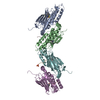
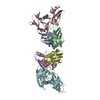
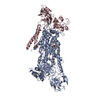


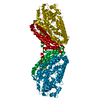


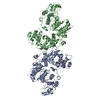
 PDBj
PDBj












